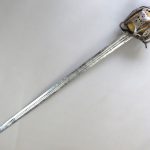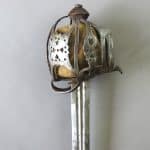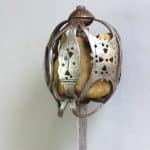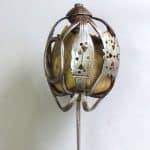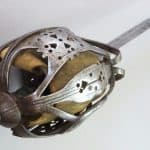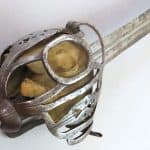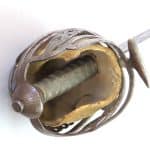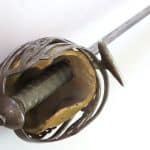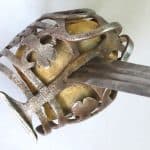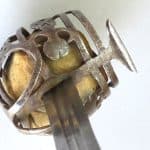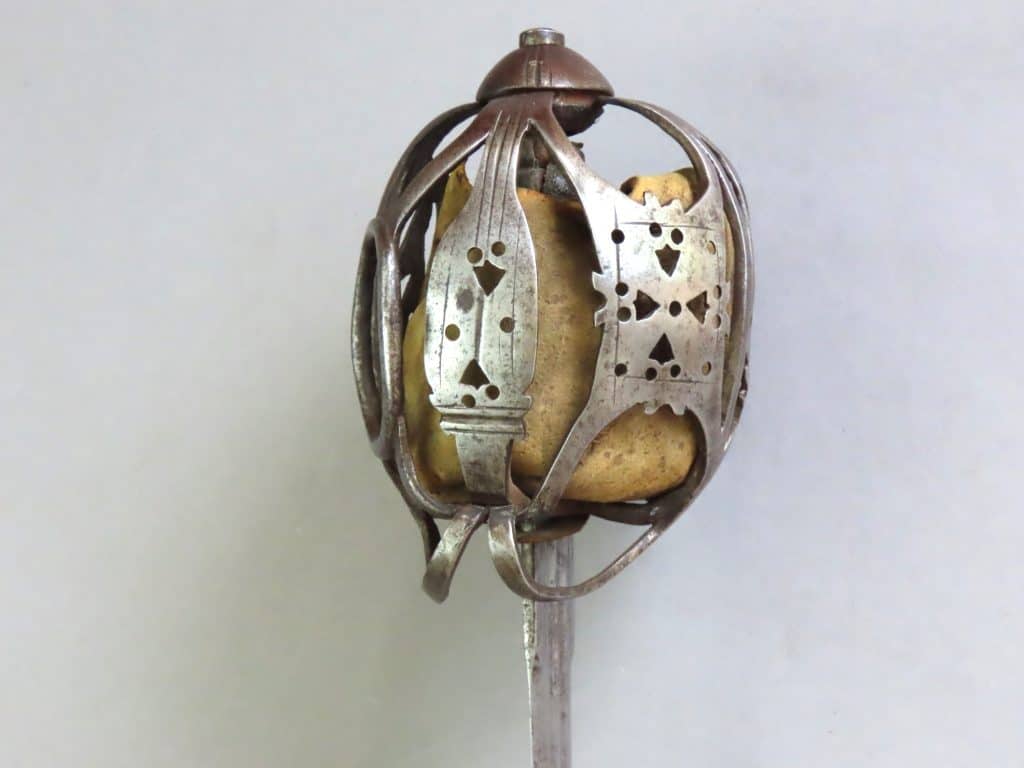
A Scottish Basket Hilted Sword for a Horseman dating to circa 1720 to 1730
To enquire about this itemplease click here
Price: £6,700
Ref: 42502517
Item Description
A Scottish basket hilted sword dating to circa 1725. The hilt is of traditional Scottish type forged from flattened iron bars and mounted with a Horseman’s oval ring which replaces one of the two frontal guard plates more usually seen mounted on traditional Scottish swords. This open ring became more common as the first half of the 18th century progressed. Swords with this feature could be used by foot soldiers as well as cavalry. The double edged blade is of exceptional quality from a German workshop. The sword is in fine and original condition and a good representation of the Scottish armourer’s craft during the period between the failed Jacobite Rebellions of 1715/19 and 1745.
The basket guard is made in the traditional Scottish manner. The guard arm tops are secured in a groove chiselled around the pommel just below its middle. The main front guard plate is pierced with circle and triangle shapes, incised with border lines and filed at its four edges with a merlon. The knucklebow and side guard plates are pierced in the same manner with vertical incised lines on each plate with lateral lines at the bottom.
The oval guard is mounted on four separate bars of saltire shape. The rear quillon is cut with decorative lines underneath at the places where the rear and secondary rear guard bars are fixed and terminates in a wide downwardly scrolled wrist guard. Forward loop guard bars emanate downwards from the side bars and curve forwards to join the front quillon at the base of the knucklebow. The cross bar of the guard forming the front and rear quillons slopes markedly downwards from back to front in early style. The pommel is a flattened dome shape and mounted with a button of separate manufacture on top from which four sets of triple lines radiate to the pommel edge.
The grip is made from a baluster shaped spirally grooved wooden core, covered with shagreen. The original wire binding is now missing. The hilt retains its original thick leather liner stitched into shape.
The broad blade is of exceptional quality as is often found on 17th and early 18th century Scottish basket hilted swords. It is 33.5 inches (85 cm) long and tapers gradually to its tip. A prominent ricasso of 2 inches (5 cm) length is incised with pairs of border lines on each side, and on one side with two indistinct blade makers stamps. Two deep and well formed fullers extend from the hilt on each side along the middle tapering gently in line with the blade to terminate 5.5 inches (14 cm) from the tip. Each fuller is stamped in capitals with “A N D R I A F E R A R A” accompanied by double “X” marks at the middle and sides.
The blade was probably made in Solingen in modern day Germany. The name Andria Ferara seems to refer to a late 16th century Italian smith who forged a great reputation. For nearly two centuries afterwards the name was adopted by many German blade makers and stamped onto their blades in various guises as a mark of quality. Although mainly illiterate the name seems to have been significant with Scottish Highlanders given the frequency with which it occurs on surviving Scottish swords from the period.
The sword is in good condition. The blackened patchy patination is consistent all over. These blackened patches are best described as shallow blackened stains rather than rust.

